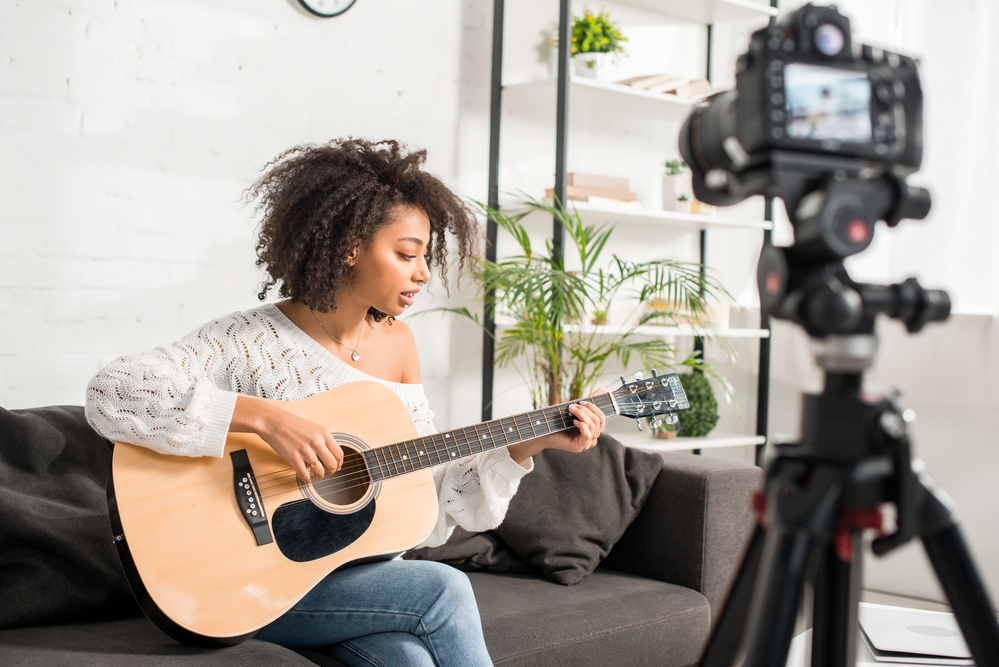Live streams are the new live concerts musicians can use while we’re in lockdown.
Though they are a far cry from the actual live show at a venue, they allow a unique opportunity for musicians to reach fans in new ways. Streaming means anyone who follows the musician can tune into the stream and view alongside fellow fans.
Live streams are events, and there are several ways that musicians can maximize the quality to serve their fanbase better.
Using Live Streams
Live streams can help artists do many things. While fans may be familiar with musicians from live shows, performance videos, or other kinds of content, live streams give audiences a closer connection to the musician.

Blog Post
"*" indicates required fields
By submitting this form, I authorize Musicians Institute (MI) to make or allow the placement of calls, emails, and texts to me at the phone number that I have provided, including through the use of automated technology, or a prerecorded or artificial voice. I understand that I am not required to provide my phone number as a condition of purchasing any property, goods, or services. I agree to the terms of MI’s Privacy Policy. MI will not sell or rent your information to third parties, and you may unsubscribe at any time.
Fans are also able to spend time with other people who live the same kind of music. Ultimately, these events foster a stronger community while also giving the artists a unique way to reach fans.
Musicians can use the following guidelines to have a lasting impact on their live stream attendees.
Plan Your Program
Some streams happen out of the blue. Artists might just want to greet their fans and see what they’re up to.
These can be fun, but it’s usually a better idea for the artist to plan what they’re going to do on the live stream. The great thing is that live streams are very versatile. Besides live performances, musicians can give tutorials, share stories, give life updates, or answer questions.
They can even do a mix of these different ideas in one stream. The important thing is that fans know what to expect and the musician knows how to prepare the stream.
Stream Across Several Channels
Youtube, Facebook, Instagram, and Twitch are all popular places for live streams.
There are a few platforms that are known for live streaming. Musicians can select which platform they want to use, but it’s also a good idea to simultaneously stream across a few channels. The process of streaming across a few platforms is called simulcasting.
Streaming across all of the platforms might be an option, but the setup for all of those platforms can be a challenge. Streaming across one or two might be optimal for your followers to gather in just a few places.
No matter the platforms, the goal is for the fans to have the best experience. Musicians should be familiar with the different features of the platforms they use when they live stream to interact with their fans in real-time.
Musicians need to pay attention to the flowing comments and questions that fans write during the streams. Reading these comments aloud excites the audience and encourages them to keep typing and energy up.
Consider the Setting
Live streaming is enjoyable when the musician is in a comfortable setting. This might be at their house, in their room, or in the studio. In any of these situations, artists need to make sure that the audience can see them clearly. That means the rooms should be lit or offer a pleasant ambiance with lighting to make the background enjoyable while the musician performs or talks.
The setting is essential because it also invites viewers to ask questions. Books, pictures, souvenirs, or other paraphernalia in the background could probe questions from viewers. That interaction will make a live stream more engaging for everyone.
Clear Audio
It’s difficult to want to tune into a live stream that doesn’t have quality audio. If the audio is too loud, too quiet, or unclear, viewers will likely stop watching.
Musicians should test their microphones and other equipment to ensure that the sound levels work with the platforms they’re using. Musicians should use dedicated microphones if they intend to perform. Often smartphone or laptop microphones are sensitive and don’t offer the best quality audio for performances.
Volume control is also important so the viewers can understand what the musician is saying to ask questions, comment, and engage. Keeping the audio clear is one of the best ways musicians enhance the experience of their online events.
Promote and Schedule Next Live Streams
Musicians can keep their streams well-attended by scheduling and announcing subsequent live streams at the end. Viewers can take note and spread the word about the next event to be present and participate.
This will keep the community excited about what’s coming next. Musicians can also talk about what kind of live stream events they want to do in the future and receive instant audience feedback from their viewers.
Final Thoughts
Live streaming may not replace live performance, but it offers many unique capabilities for musicians. These events are convenient to put on and are also effective for developing a relationship with an audience.

